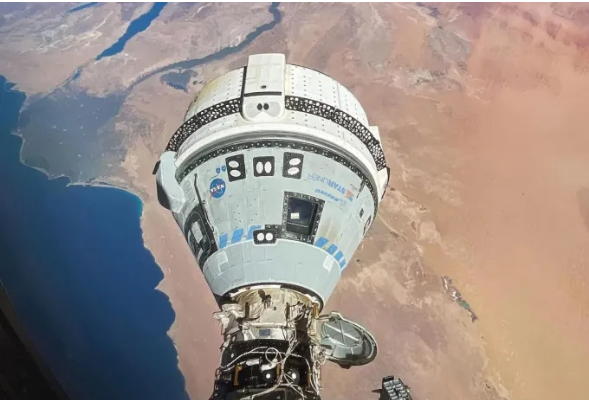
We are at the dawn of a new space age. If you doubt, simply look back at the last year: From SpaceX’s historic catch of the Super Heavy booster to the record-breaking number of lunar landing attempts, this year was full of historic and ambitious missions and demonstrations.
We’re taking a look back at the five most significant moments or trends in the space industry this year. Naysayers might think SpaceX is overrepresented on this list, but that just shows how far ahead the space behemoth is in relation to its competitors.
In no particular order:
1. Boeing’s bungled Starliner mission turns into a SpaceX win
NASA and Boeing no doubt had high hopes when the Starliner vehicle lifted off for its first crewed test mission in June. But a series of technical malfunctions occurred as the vehicle made its final approach to the International Space Station, which kicked off a months-long investigation into those problems, with the chief concern being whether the two onboard astronauts could safely use Starliner to come back home.
Out of an abundance of caution, that the two astronauts would stay aboard the ISS for many more months than originally planned, and that they would return using a SpaceX Dragon capsule in the spring. The decision was a major blow to Boeing, which has incurred about $1.6 billion in cost overruns developing Starliner, and may need to conduct another crewed test flight before the vehicle can be certified to fly regularly for NASA. (For what it’s worth, the capsule performed a flawless touchdown.)
2. SpaceX catches Super Heavy for the first time
SpaceX made incredible progress in its Starship test program, with the company launching the massive rocket four times in 2024, bringing the total launches to six overall. During the fifth flight in October, the Super Heavy booster flew back to the launch site, and was “caught” by two large arms jutting out from the launch tower.
The space company nailed booster reuse with its workhorse Falcon 9 rocket, with the company successfully recovering 367 boosters to date. These boosters touch down on land or on massive ships at sea using four legs that are autonomously deployed right before touch down. But using a similar technique to recover the Super Heavy is impractical for a number of reasons — chiefly its massive size — which led SpaceX engineers to develop the booster catch method.
During the most recent launch test in November, SpaceX decided to scrub a second catch attempt, so there is clearly still work to do to hit the kind of launch and recovery cadence the company is aiming for. But the catch marked a historic day in spaceflight — not to mention, arguably one of the most incredible engineering feats of the century so far.
3. Polaris Dawn crew performs first private spacewalk
Jared Isaacman has been in the news recently due to his nomination to the role of NASA Administrator by incoming President Donald Trump. But the billionaire founder of payment processing company Shift4 Payments also made headlines this year when he led the Polaris Dawn mission and performed the first commercial spacewalk.
Spacewalks are incredibly dangerous: in leaving their vehicle, astronauts expose themselves to risks like micrometeoroids and radiation, not to mention having to rely on the integrity of their spacesuits to provide essentials like oxygen and cooling. Yet the crew of Polaris Dawn, along with their mission partners SpaceX, took on exactly these challenges with the mission. Two of the four crew members, Isaacman and SpaceX engineer Sarah Gillis, took turns emerging from the top of their vehicle, a specially equipped Dragon, for about ten minutes each. The pair performed a series of tests on the SpaceX-made spacesuits while connected to the vehicle via umbili
4. Multiple firms take aim at the moon
This year, two private companies and two nations attempted to touch down on the moon. While the total number of attempts is not a record, the breadth of players certainly is: Japan, China, and two American companies all took the
5. The Space Force pays out
We’d be remiss not to mention one of the space industry’s single largest customers — the Department of Defense — whose priorities and spending shape the ecosystem overall. This year, the Space Force awarded a number of major contracts to commercial providers, signaling that it’s willing to pay big dollars to commercial entities that can deliver.
As we bid farewell to 2024, it’s essential to reflect on the significant milestones achieved in the space industry. This year witnessed numerous groundbreaking developments, from historic missions to innovative technological advancements. In this article, we’ll revisit the biggest moments in the space industry in 2024.
1. NASA’s Artemis Program Takes a Giant Leap
In November 2024, NASA’s Artemis program achieved a significant milestone with the successful launch of the uncrewed Artemis I mission. The mission aimed to test the Space Launch System (SLS) rocket, the Orion spacecraft, and the crew’s safety systems. The mission’s success paved the way for future crewed missions to the lunar surface, with the ultimate goal of establishing a sustainable human presence on the Moon.
2. SpaceX’s Starship Reaches New Heights
In March 2024, SpaceX’s Starship program achieved a significant milestone with the successful test flight of the Starship SN9 prototype. The test flight demonstrated the vehicle’s ability to reach an altitude of 10 km (6.2 miles) and return safely to Earth. This achievement marked a crucial step towards the development of a reusable spacecraft capable of transporting both crew and cargo to the Moon, Mars, and other destinations in the solar system.
3. China’s Lunar Lander Makes History
In January 2024, China’s National Space Administration (CNSA) achieved a historic milestone with the successful landing of the Chang’e 7 lunar lander on the far side of the Moon. The mission marked the first time a spacecraft had landed on the far side of the Moon, and it demonstrated China’s growing capabilities in space exploration.
4. ESA’s JUICE Mission Explores Jupiter’s Moons
In April 2024, the European Space Agency (ESA) launched the JUICE (JUpiter ICy moons Explorer) mission, which aims to explore Jupiter’s icy moons, including Ganymede, Europa, and Callisto. The mission will study the moons’ subsurface oceans, surfaces, and atmospheres, providing valuable insights into the formation and evolution of our solar system.
5. Blue Origin’s New Glenn Rocket Takes Flight
In October 2024, Blue Origin’s New Glenn rocket made its maiden flight, successfully reaching orbit and deploying a payload of satellites. The New Glenn rocket is designed to be reusable, with the ability to launch payloads into orbit and return to Earth for refurbishment and reuse.
6. India’s Chandrayaan-3 Mission Makes a Soft Landing on the Moon
In August 2024, India’s Chandrayaan-3 mission achieved a significant milestone with the successful soft landing of the Vikram lander on the lunar surface. The mission marked India’s second attempt to land on the Moon, following the failure of the Chandrayaan-2 mission in 2019.
7. NASA’s Perseverance Rover Discovers Evidence of Past Water on Mars
In June 2024, NASA’s Perseverance rover discovered evidence of past water on Mars, including sedimentary rocks and minerals that form in the presence of water. The discovery provided valuable insights into the Martian environment and the potential for life on the Red Planet.
8. SpaceX’s Crew-5 Mission Launches to the ISS
In September 2024, SpaceX’s Crew-5 mission launched to the International Space Station (ISS), carrying a crew of four astronauts on a six-month mission. The mission marked the fifth operational crew rotation flight to the ISS aboard a SpaceX Crew Dragon spacecraft.
9. ESA’s Euclid Mission Prepares for Launch
In December 2024, the ESA’s Euclid mission completed its final preparations for launch, scheduled for 2025. The mission aims to study the distribution of dark matter and dark energy in the universe, providing valuable insights into the nature of the cosmos.
10. China’s Tiantan-1 Space Station Module Launches into Orbit
In November 2024, China’s Tiantan-1 space station module launched into orbit, marking a significant milestone in the development of China’s space station program. The module will serve as a core component of the space station, providing living quarters, life support systems, and propulsion.
As we look back on the biggest moments in the space industry in 2024, it’s clear that this year has been marked by significant achievements and milestones. From historic missions to innovative technological advancements, the space industry continues to push the boundaries of what is possible. As we look to the future, it’s exciting to think about what’s to come in 2025 and beyond.
Revisiting the biggest moments in the space industry in 2024 provides numerous benefits for individuals, organizations, and the space industry as a whole. Here are some of the advantages of reflecting on the past year’s achievements:
Benefits for Individuals
1. Inspiration and Motivation: Revisiting the biggest moments in the space industry in 2024 can inspire and motivate individuals to pursue careers in STEM fields (science, technology, engineering, and mathematics) and to contribute to the advancement of space exploration.
2. Knowledge and Understanding: Reflecting on the past year’s achievements can help individuals gain a deeper understanding of the space industry, its challenges, and its opportunities.
3. Perspective and Context: Revisiting the biggest moments in the space industry in 2024 provides perspective and context, helping individuals to appreciate the progress made and the challenges overcome.
Benefits for Organizations
1. Strategic Planning and Decision-Making: Revisiting the biggest moments in the space industry in 2024 can inform strategic planning and decision-making, helping organizations to identify opportunities, challenges, and areas for improvement.
2. Innovation and Collaboration: Reflecting on the past year’s achievements can inspire innovation and collaboration, as organizations seek to build on the successes of others and to address common challenges.
3. Marketing and Communications: Revisiting the biggest moments in the space industry in 2024 can provide valuable material for marketing and communications efforts, helping organizations to promote their achievements and to attract new customers, partners, and talent.
Benefits for the Space Industry as a Whole
1. Promoting Public Awareness and Engagement: Revisiting the biggest moments in the space industry in 2024 can help to promote public awareness and engagement, inspiring a new generation of space enthusiasts and supporters.
2. Fostering Collaboration and Cooperation: Reflecting on the past year’s achievements can foster collaboration and cooperation, as organizations and individuals seek to build on the successes of others and to address common challenges.
3. Informing Policy and Regulatory Decisions: Revisiting the biggest moments in the space industry in 2024 can inform policy and regulatory decisions, helping governments and regulatory bodies to create a supportive environment for space exploration and development.
Benefits for Future Space Exploration and Development
1. Informing Future Mission Planning and Development: Revisiting the biggest moments in the space industry in 2024 can inform future mission planning and development, helping organizations to build on the successes of others and to address common challenges.
2. Identifying Areas for Improvement: Reflecting on the past year’s achievements can help to identify areas for improvement, such as technological advancements, operational efficiencies, and risk management strategies.
3. Inspiring New Generations of Space Explorers: Revisiting the biggest moments in the space industry in 2024 can inspire new generations of space explorers, engineers, and scientists, helping to ensure a bright future for space exploration and development.
Conclusion
Revisiting the biggest moments in the space industry in 2024 provides numerous benefits for individuals, organizations, and the space industry as a whole. By reflecting on the past year’s achievements, we can gain inspiration, knowledge, and perspective, while also informing future mission planning and development, identifying areas for improvement, and inspiring new generations of space explorers.



